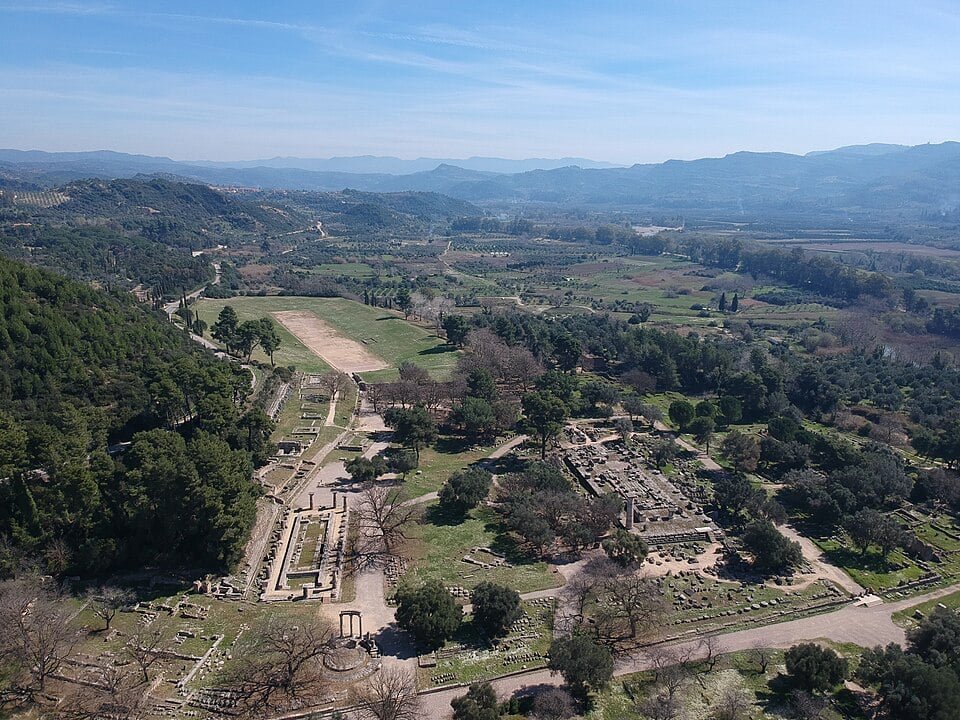
A long-vanished lake once shaped the landscape of ancient Olympia (Greek: Ολυμπία), the birthplace of the Olympic Games and one of Greece’s most sacred sanctuaries. Researchers now say this lost lake was central to the city’s daily life and rituals, providing water, space for livestock, and possibly even a setting for religious acts.
The study, led by Lena Slabon and published in Quaternary Environments and Humans, shows that Olympia was not only framed by the rivers Alpheios and Kladeos but also bordered by a vast lake system.
Sediment cores reveal that the lake stretched across the Makrisia and Ladiko basins and existed from the 8th millennium BC until at least the 6th century AD — overlapping with the centuries when the Olympic Games flourished.
A sanctuary on the water’s edge
Olympia was more than a sporting venue. It was a sanctuary to Zeus, filled with temples, altars, and monuments. Each summer, pilgrims arrived from across the Greek world to honor the gods and compete.
Water was essential to sustain the athletes, feed the crowds, and conduct sacrifices. Researchers believe the lake helped meet these needs.
Wells excavated within the sanctuary align with the reconstructed shoreline, suggesting they were fed by lake-controlled groundwater. That means the water supply for the Olympic Games, long thought to come mainly from rivers, was tied closely to the lake.

The lake may have served other purposes. Its shallow edges likely supported grazing herds, which supplied food during the games. It may also have been used for fishing, washing, or ritual purification tied to Greek religious practices.
Ancient sources stay silent
Curiously, ancient authors never mention a lake. Xenophon, Pindar, and Pausanias wrote in detail about Olympia’s rivers and fertile land. They described meadows, hunting grounds, and monuments, but not a body of water near the sanctuary.
This silence has puzzled scholars. Was the lake too shallow or seasonal to merit description? Did visitors simply overlook it in favor of temples and competitions? Or does the absence reflect the way ancient writers chose to present Olympia’s sacred geography?
More than sport and worship
The study suggests the lost lake of ancient Olympia was as much a part of the games as the stadium or temple. During the height of the Panhellenic Games, researchers say the lake experienced strong eutrophication, likely from the presence of massive crowds, livestock, and wastewater.
The lake was part of Olympia’s story as much as the temples and competitions. Slabon explained that it connected people, animals, and rituals.
A thread/photographic essay of humans among Classical ruins where Time, master of men, reigns supreme.
A Peloponnesian shepherd sits among the ancient ruins of the athletes’ entrance to the Olympic stadium in Olympia, Greece c.1907 pic.twitter.com/mKKVuVCAna
— Michel Lara (@VeraCausa9) November 29, 2019
The lake may also have served as a transport route, allowing goods and building materials to reach the sanctuary more easily. Some shallow areas may have provided paths to cross the valley on foot.
A puzzle that remains

For now, the lake adds a missing layer to Olympia’s history. It explains how the sanctuary could sustain thousands of visitors, yet it also raises questions about why ancient texts ignored such a striking feature.
What is clear is that Olympia was not only shaped by myth, stone, and sport. It was shaped by water — a lake that once sustained its games, rituals, and people, before disappearing from both the land and memory.


